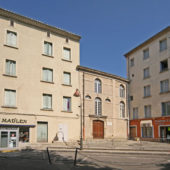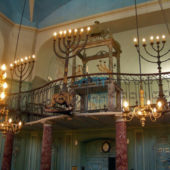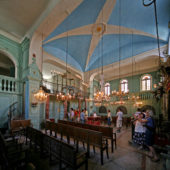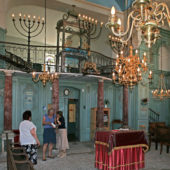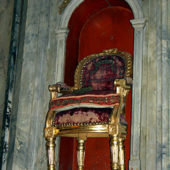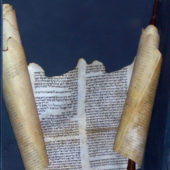One of the most remarkable synagogues of Provence, the Carpentras Synagogue, bears the hallmarks of a unique history specific to the Jews of this region.
One of the most remarkable synagogues of Provence, the Carpentras Synagogue, bears the hallmarks of a unique history specific to the Jews of this region. The present structure, built in 1774 in a place of another synagogue dating to the 15th Century, features many of the extravagant decorative flourishes and color palette (including pink, gold, green and blue) of the Rococo style that was fashionable at the time. Gold and crystal chandeliers hang over the main room and the gilded ark is flanked by neo-classical columns topped with carvings of flowers indigenous to Provence.
The unique history of Jews in Provence conspicuously sets apart the Carpentras synagogue — along with just a handful of others in the region — from synagogues in the rest of France and throughout Europe. In the 14th Century, France expelled the Jews, but the Pope offered them refuge in Provence, a papal territory in the south. For about a century, the Papacy made its headquarters in Avignon. The Jews of Provence became known as the “Pope’s Jews” and there they lived in relative freedom, enjoying the Pope’s protection (though they were made to observe curfews and wear identifying hats) and being employed in many occupations and professions.
With the departure of the Papacy back to Rome in the 16th Century, the status of Jews began to decline once again until the French Revolution. Nevertheless, this brief era made a lasting imprint on the Jews of the region and was reflected in their synagogue construction and décor. Foremost among the differences of the Carpentras synagogue compared to other synagogues is the elevated role, literally, of the rabbi. While Sephardic congregations tended to place the rabbi in the midst of fellow worshipers and the Ashkenazi congregations placed the rabbi in front of worshippers, the Carpentras synagogue and others in Provence placed the rabbi above the congregation on a tribune, an elaborate wrought iron balcony. The rabbi would conduct the service from this lofty perch accessible via dual staircases on either side. This elevated platform is similar to Christian tradition in which the priest or pastor speaks from a pulpit above the congregation. Wealthy men of the community sometimes joined the rabbi on the tribune while the rest of the men watched from the floor below. The ornately carved ark, painted in blue and gold, is located beneath the tribune.
In keeping with Jewish tradition of the day, men and women were kept separate during worship and in this case, instead of being separated by a curtain or relegated to a balcony, the women were confined to a basement where they could hear the service via a conduit that also was used to raise matzoh up to the prayer hall. In fact, the basement also served as the synagogue’s bakery. Another striking deviation is “Elijah’s Chair,” a small, golf leaf covered chair with a red velvet seat that is mounted 20 feet above the floor in the corner of the prayer hall (see photo). Circumcisions were performed beneath this chair in order to invite the prophet’s blessing on the child.
Life for Jews in Provence and across all of France improved markedly after the French Revolution of 1789. Since then, the Carpentras Synagogue has undergone many changes since including a restoration after World War II. With few Jewish families now residing in the region, the Carpentras Synagogue no longer serves as a house of worship but remains a telling artifact of a different time. The synagogue is open for tours by permission.

